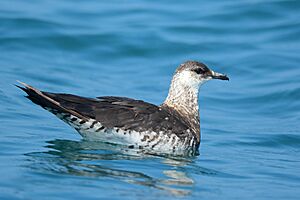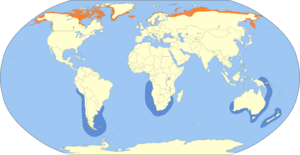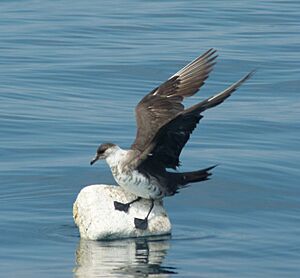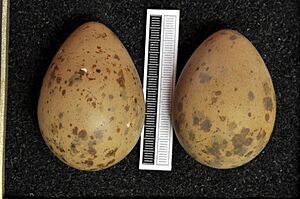Parasitic jaeger facts for kids
Quick facts for kids Parasitic jaeger |
|
|---|---|
 |
|
| Conservation status | |
| Scientific classification | |
| Genus: |
Stercorarius
|
| Species: |
parasiticus
|
 |
|
| Synonyms | |
|
Larus parasiticus Linnaeus, 1758 |
|
The parasitic jaeger (called the Arctic skua in Europe) is a cool seabird from the skua family. These birds are amazing travelers! They breed in cold northern places like Scandinavia, Scotland, Iceland, Greenland, Northern Canada, Alaska, and Siberia. When winter comes, they fly all the way to the southern parts of the world. They get their name because they often steal food from other birds, which is a special way of finding meals.
Contents
What's in a Name?
The word "jaeger" comes from the German word Jäger, which means "hunter". This makes sense because they are skilled hunters! The English word "skua" comes from the Faroese name skúgvur. This name was first used for the great skua, a larger type of skua.
The scientific name for this bird is Stercorarius parasiticus. The first part, Stercorarius, is Latin and means "of dung". Long ago, people thought the food skuas made other birds drop was actually waste. The second part, parasiticus, is also Latin and means "parasitic". This refers to their habit of stealing food from other birds.
How to Spot Them
It can be tricky to tell a parasitic jaeger apart from its relatives, like the long-tailed jaeger or pomarine jaeger. This is because parasitic jaegers come in three different color types, called morphs.
These birds are fairly small for a skua. They are about 41 to 48 centimeters (16 to 19 inches) long. Their wings can spread out from 107 to 125 centimeters (42 to 49 inches). They weigh between 300 and 650 grams (10.5 ounces to 1.4 pounds). The long tail feathers of an adult bird add about 7 centimeters (2.7 inches) to their length.
Color Morphs
- Light-morph adults have a brown back and mostly white undersides. Their main wing feathers are dark with a white "flash" that you can see when they fly. Their head and neck are yellowish-white with a black cap. They have a pointed central tail feather.
- Dark-morph adults are dark brown all over.
- Intermediate-phase birds are dark but have slightly paler undersides, head, and neck.
All three color types have the white "flash" on their wings.
Young Birds
Spotting young parasitic jaegers is even harder! It is tough to tell them apart from young long-tailed jaegers. Parasitic jaegers are usually a bit bigger and have shorter wings. They often have warmer, browner colors instead of gray. They also fly more like a falcon. The parasitic jaeger is the most common type of jaeger you might see from the shore.
Calls
When these birds are displaying, they make a nasal, mewing sound that they repeat a few times. If they are alarmed, their call is shorter.
Behavior and Life Cycle
Reproduction
These birds breed in the northern parts of Eurasia and North America. You can find large groups as far south as northern Scotland, including places like Shetland and Orkney. In North America, they breed in Alaska, Yukon, and other northern areas.
They build their nests on dry tundra, higher hills, and islands. A female bird usually lays up to four olive-brown eggs. When they are on their breeding grounds, jaegers are mostly quiet. However, they will make mewing and wailing sounds. Like other skuas, they will fly at the head of a human or fox that gets too close to their nest.
Migration
The parasitic jaeger is a migratory bird. This means it travels long distances. They spend their winters at sea in warm tropical areas and the southern oceans. While most of their journey is over the ocean, some birds fly over land. For example, some fly over the Canning River Valley in Alaska in the spring. In the fall, some fly from northern Russia to the Persian Gulf. American populations sometimes fly over the Great Lakes, especially Lake Ontario.
Feeding Habits
During the breeding season, these birds eat small animals like rodents, insects, eggs, chicks, and small birds. However, most of their food, especially in winter and during migration, comes from stealing! This special way of feeding is called kleptoparasitism. They chase other birds, usually gulls and terns, until those birds drop the food they have caught. Then, the jaeger swoops in and grabs the meal.
Conservation Status
Globally, the parasitic jaeger is listed as a species of "Least Concern." This means their numbers are generally stable. However, in Iceland, their numbers dropped a lot in the early 2000s. Because of this, in 2018, they were listed as "Endangered" in Iceland. This shows that even if a species is doing well overall, it might need help in certain areas.






